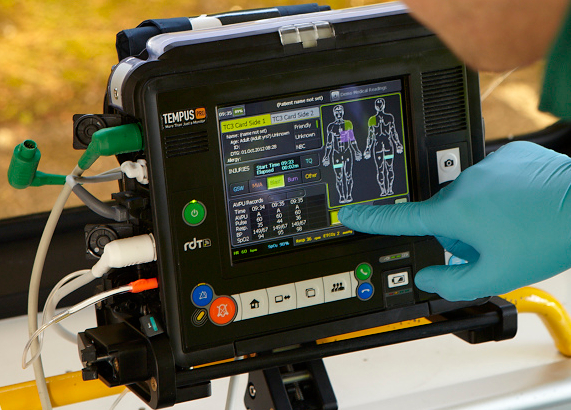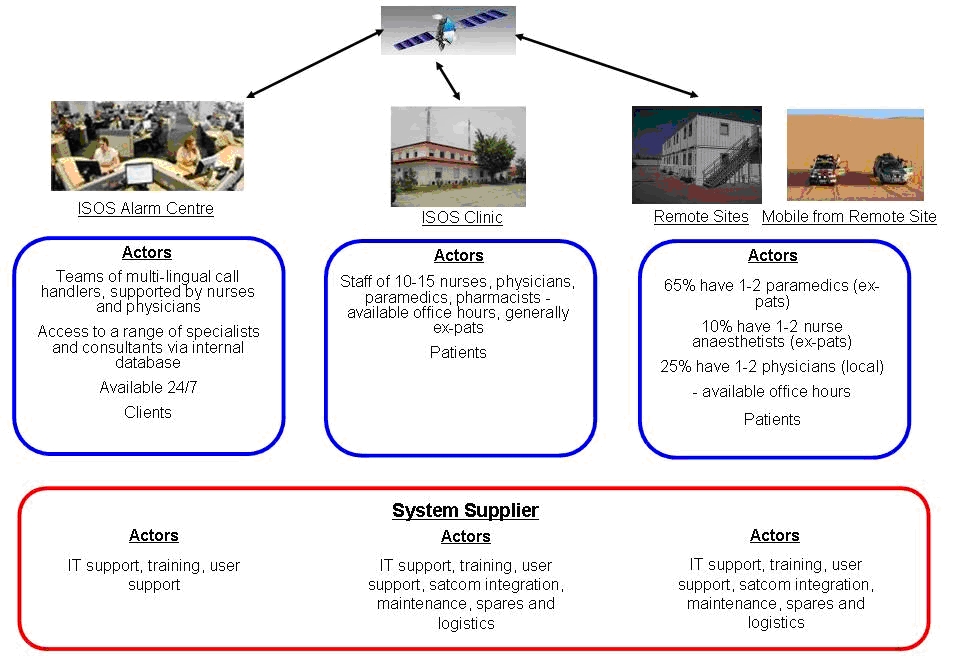
Objectives of the service
The objective of the project is the development, integration, testing and validation of a tele-assistance service, making use of multiple space assets (Satcom, Satnav), for professional clinical users in remote locations using a highly compact device for vital-sign monitoring and remote diagnosis.
Users and their needs
Many organisations have a large international presence with staff operating concurrently in a multitude of locations. Examples of such organisations include Governments; Military; NGOs; Charities and Mineral and energy companies.
Such organisations use the services of companies like International SOS to provide them with medical support. Intl. SOS provides medical and security services through an extensive network of offices, staffed with clinical personnel, such as physicians, nurses and paramedics. They are able to provide direct medical care, which is also supported by a network of alarm centres, which are in turn staffed by doctors, nurses and specialist call handlers. These users are targeted to use the proposed system, as shown in the diagram below:
Service/ system concept
A number of commercial and user benefits exist for the proposed system. These include:
- Reduced costs from avoided medical evacuations (MEDEVACs) from remote sites;
The system would enhance their offering in remote sites (through telemedicine) and therefore improves the value proposition of their service; - The dual-use and ease of use features will allow the use of lower-skilled resource (e.g. nurses instead of doctors) in remote sites, this would improve their margin and also enabling additional sites to take up Intl. SOS service i.e. obtain new customer sites;
- The system would enable them to provide better quality of care at existing sites where they already utilise lower-skilled resource which would lead to improved utilisation of their client's workforce;
- The system would improve the value obtained from their existing infrastructure investment in clinics e.g. by the integration and transmission of data from 3rd party ultrasound and blood analysis products;
- Furthermore, the ability to link the remote sites and clinics much more closely into Intl. SOS's existing Global Alarm centres would improve the value they obtain from their existing infrastructure enabling them to obtain additional value from existing assets;
- The enhanced offering in clinics would improve the overall value proposition;
- The system would allow new services to be offered (from clinics and alarm centres) for remote sites that otherwise would not be staffed.
Space Added Value
The integration with different space-based assets in the development of the proposed system is expected to add value to the user in a number of ways.
- Reduced costs from avoided MEDEVACs from remote sites
- Enhanced offering in remote sites (through telemedicine) improves value proposition
- Dual-use and ease of use features allows use of lower-skilled resource (nurse instead of doctor) in remote locations, improving margin and/or enabling additional sites to take up Intl. SOS service
- Better quality of care at existing sites where they already utilise lower skilled resource
- Improvement of value obtained from existing infrastructure investment in clinics
- Enhanced offering in clinics improves value proposition presented by the service provider
- The system would allow services to be offered (from clinics and alarm centres) to new remote sites (typically with no medical staff) which otherwise would not be able to access the medical service.
These commercial benefits will be driven by the integration both of high-quality GPS positioning and real-time communications via satcom.
These, combined with leading medical technologies and a unique feature set based on a flexible platform is expected to create a new level of service delivery in pre-hospital care.
Current Status
Previous to the final review held at ESTEC in Dec 2013, RDT partnered with Intl.SOS, to demonstrate the device working in real-life situations, under rugged conditions, over a six-week period in Algeria and Nigeria. During the trials, 53 successful connections were made; totalling more than 5 ½ hours of telemedicine calls.
Not only was sharing the data useful in getting a second opinion of the patient’s condition and to help ascertain whether to Medevac or not, but it was also useful in providing a second pair of eyes, both literally via the digital camera and also generally via the medical data and trends overview, especially for the remote sites that have very little on-site support. For example during one connection the Paris alarm centre was able to highlight (using a photo) incorrect positioning of a twelve lead ECG and how to rectify it.
The AMAZON telemedicine service relying on the Tempus Pro device has been very well received during the project trial by both the Intl.SOS clinic and remote site staff and also their customers who have had the chance to see the device. Tempus Pro has proven to be a game changer in this environment and has succeeded at being both a valuable telemedicine device whilst being a market leading fully featured vital signs monitor with unsurpassed weight, size and robustness, perfectly balanced to be at home in a remote austere environment as much is it is in a well-equipped, modern clinic.
Tempus Pro was cleared for market with both CE marking and 510k (FDA) approval in June 2013. It has already exceeded RDT’s expectations in market acceptance and has been sold to a number of NATO militaries and the oil and gas industry, with huge amounts of interest being generated. iSOS is also extremely of the quality of the telemedicine service provided through the device.
RDT has been awarded an extension of the project to enhance the capabilities of the AMAZON service and the associated TEMPUS PRO system, which shall allow to address new business opportunities such as the civilian pre-hospital care market. This new phase, named JACKSON project, is presented in a dedicated webpage of the ARTES Applications website.
Prime Contractor(s)
Subcontractor(s)





